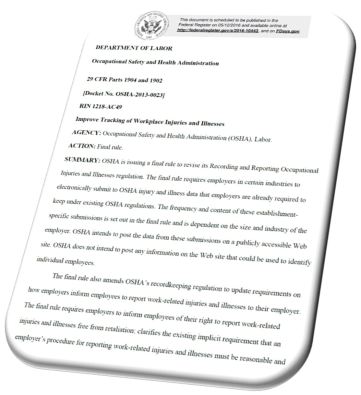By Eric J. Conn
The December 15, 2017 deadline for large employers and small employers in certain “high hazard industries” to submit injury and illness data to OSHA has just passed, but it is not too late to submit injury data without being cited by OSHA for missing the deadline.  OSHA announced today that will continue to accept employers’ 300A annual summary injury data for calendar year 2016 through the agency’s new Injury Tracking Application (ITA) (the portal that will receive the injury data) until midnight on December 31, 2017, and will not take any enforcement action against those employers who submit data between now and then, even though the submissions would technically be late. Beginning January 1, 2018, the portal will no longer accept 2016 data.
OSHA announced today that will continue to accept employers’ 300A annual summary injury data for calendar year 2016 through the agency’s new Injury Tracking Application (ITA) (the portal that will receive the injury data) until midnight on December 31, 2017, and will not take any enforcement action against those employers who submit data between now and then, even though the submissions would technically be late. Beginning January 1, 2018, the portal will no longer accept 2016 data.
We have closely tracked the Trump Administration’s treatment of OSHA’s new E-Recordkeeping and Anti-Retaliation Rule, and while there have been plenty of signals that this rule is due for an overhaul, or even possibly to be rescinded entirely, no such action was taken to interfere with the first required data submission, other than to extend the deadline from this summer to December 15th, and now to December 31st, for all intents and purposes.
Therefore, if employers missed the deadline, they should immediately evaluate whether the rule applies to any or all of their workplaces, get familiar with and set up an account in OSHA’s Injury Tracking Application, and submit covered injury data (i.e., their 2016 OSHA 300A Annual Summary data) by December 31, 2017.
Background about the Electronic Recordkeeping Rule
Historically, unless OSHA opened an enforcement inspection at an employer’s workplace or the Bureau of Labor Statistics requested an employer’s participation in its annual injury data survey, employers’ Injury and Illness Recordkeeping Logs and related forms remained strictly in-house. Employers kept the data and their OSHA logs in their HR or Safety Department office, posted them internally for employees to view for a couple of months each year, used the data themselves to make decisions about how to reduce risks of injuries and illnesses in their workplaces, and then stored the records in a cabinet or desk drawer for five years. Now, OSHA’s new rule requires hundreds of thousands of employers to proactively submit these historically private records to OSHA, which in turn may publish the data online for all the world to see.
Employers kept the data and their OSHA logs in their HR or Safety Department office, posted them internally for employees to view for a couple of months each year, used the data themselves to make decisions about how to reduce risks of injuries and illnesses in their workplaces, and then stored the records in a cabinet or desk drawer for five years. Now, OSHA’s new rule requires hundreds of thousands of employers to proactively submit these historically private records to OSHA, which in turn may publish the data online for all the world to see.
Key Changes in OSHA’s New Recordkeeping Rule:
- Establishments with 20-249 employees in certain so-called “high hazard industries” must each year submit information from their 300A Annual Summaries only.
- All establishments with 250 or more employees (in industries not exempt from keeping injury logs) must submit to OSHA annually their injury and illness data from their OSHA 300 Logs, 301 Incident Reports, and 300A Annual Summaries. In this first year of the rule, however, for 2016 injury data to be submitted in calendar year 2017, all employers, irrespective of size, are only required to submit 300A Annual Summary data.
- The submissions to OSHA must be made electronically, via a purportedly secure web portal.
- OSHA stated its original intent was to publish the data online, likely in a manner that is sortable, searchable, filterable, and as embarrassing to employers as possible. It is unclear whether the Trump Administration will publish the data, but the records may nonetheless be subject to Freedom of Information Act requests by plaintiffs’ attorneys, the media, union organizers, and competitors, to use the data in a variety of ways to harm employers.
Deadline to Submit Data – A Moving Target
The deadline to submit data has been a moving topic and source of uncertainty since the Trump Administration took the reins at OSHA. Continue reading →
Like this:
Like Loading...
 So we now have the final regulatory text, OSHA’s rationale for its final rulemaking decisions, and its analysis of the stakeholder comments about the proposed amended rule. Here’s what we know.
So we now have the final regulatory text, OSHA’s rationale for its final rulemaking decisions, and its analysis of the stakeholder comments about the proposed amended rule. Here’s what we know.



















